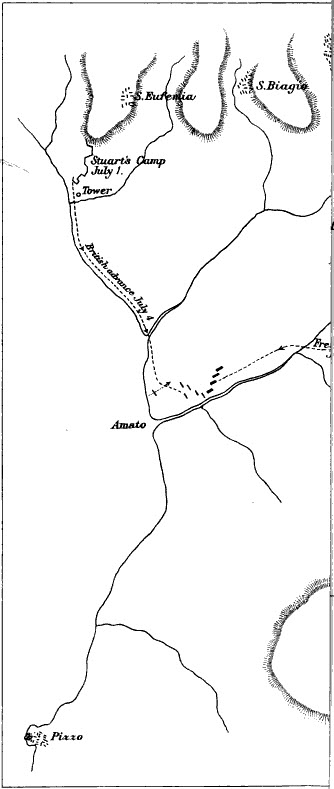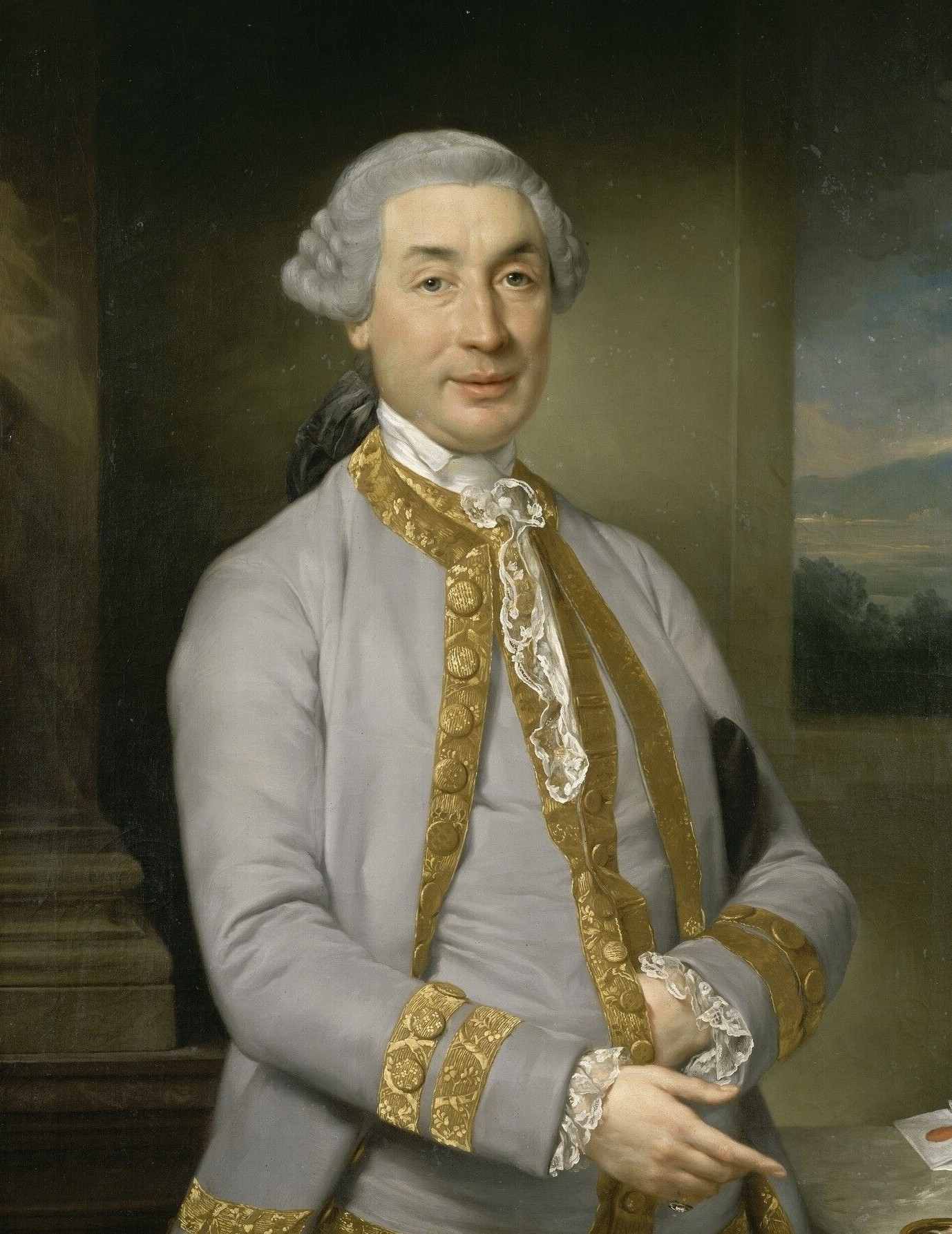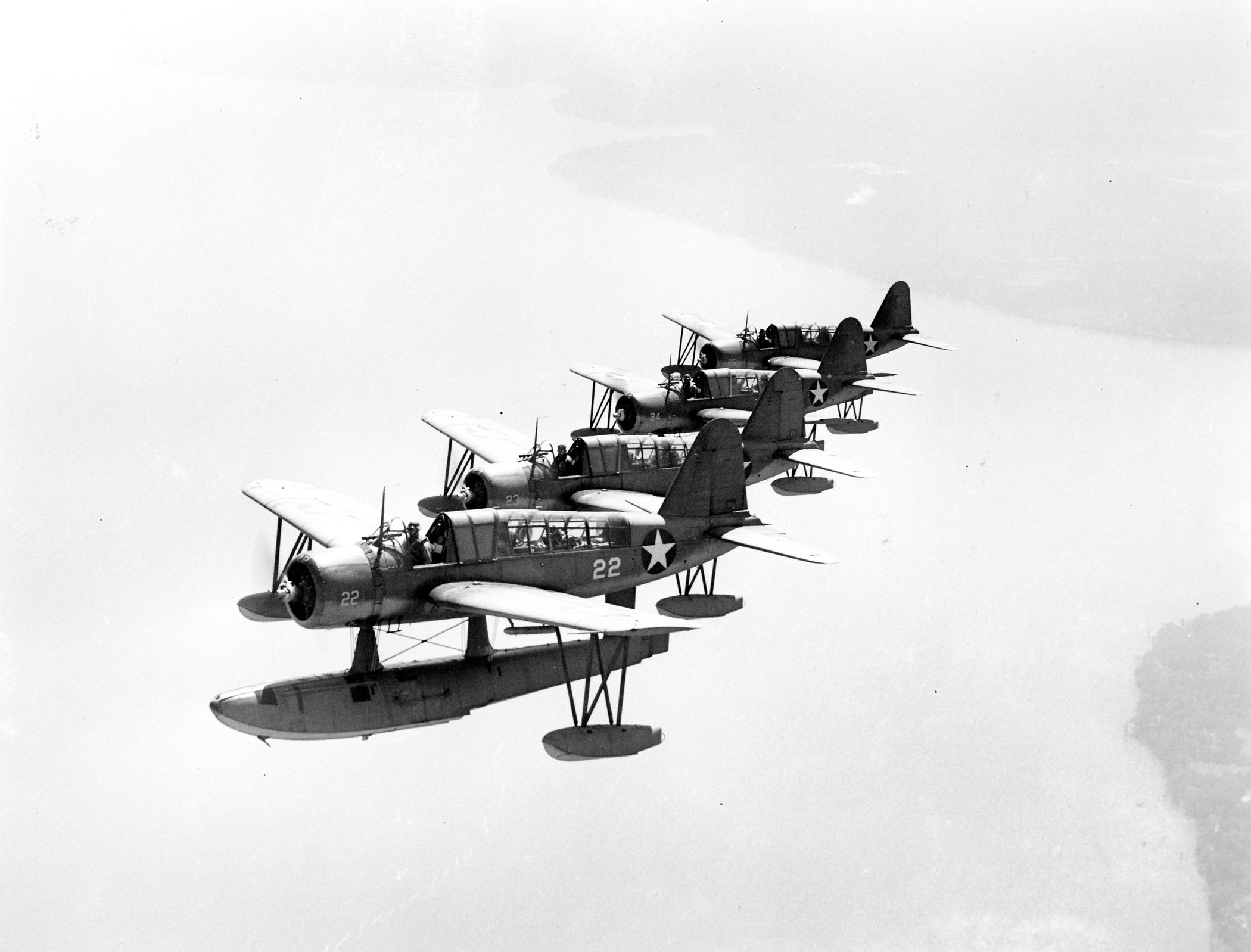|
Battle Of Maida
The Battle of Maida, fought on 4 July 1806 was a battle between the British expeditionary force and a French force outside the town of Maida in Calabria, Italy during the Napoleonic Wars. John Stuart led 5,236 British troops to victory over about 5,400 troops under the command of French general Jean Reynier, inflicting significant losses while incurring relatively few casualties. Maida is located in the toe of Italy, about west of Catanzaro. In early 1806, the French invaded and overran the Kingdom of Naples, forcing King Ferdinand I of the Two Sicilies and his government to flee to Sicily. The Calabrians revolted against their new conquerors and Stuart's expeditionary force tried to exploit the unrest by raiding the coast. While ashore, the British encountered Reynier's division and the two sides engaged in battle. The 19th-century historians presented the action as a typical fight between French columns and British lines. This view of the battle has been called into doubt b ... [...More Info...] [...Related Items...] OR: [Wikipedia] [Google] [Baidu] [Amazon] |
Invasion Of Naples (1806)
The invasion of Naples was a military campaign of the War of the Third Coalition in 1806. It began when a First French Empire, French army led by Marshal of the Empire, Marshal André Masséna marched from Northern Italy into the Kingdom of Naples, an ally of the Coalition against France ruled by Ferdinand I of the Two Sicilies, King Ferdinand IV. The Neapolitan army was defeated at Battle of Campo Tenese, Campo Tenese and rapidly disintegrated. The invasion was eventually successful despite some setbacks, including the prolonged Siege of Gaeta (1806), Siege of Gaeta, the British victory at Battle of Maida, Maida, and a stubborn guerrilla war by local peasants against the French. Total success eluded the French because Ferdinand withdrew to his domain in Kingdom of Sicily, Sicily, where he was protected by the Royal Navy and a British Army garrison. In 1806, Emperor Napoleon appointed his brother Joseph Bonaparte to rule over Southern Italy as king. The proximate cause of the inva ... [...More Info...] [...Related Items...] OR: [Wikipedia] [Google] [Baidu] [Amazon] |
Napoleon I Of France
Napoleon Bonaparte (born Napoleone di Buonaparte; 15 August 1769 – 5 May 1821), later known by his regnal name Napoleon I, was a French general and statesman who rose to prominence during the French Revolution and led Military career of Napoleon, a series of military campaigns across Europe during the French Revolutionary and Napoleonic Wars from 1796 to 1815. He led the French First Republic, French Republic as French Consulate, First Consul from 1799 to 1804, then ruled the First French Empire, French Empire as Emperor of the French from 1804 to 1814, and briefly again in 1815. He was King of Italy, King of Kingdom of Italy (Napoleonic), Italy from 1805 to 1814 and Protector of the Confederation of the Rhine, Protector of the Confederation of the Rhine from 1806 to 1813. Born on the island of Corsica to a family of Italian origin, Napoleon moved to mainland France in 1779 and was commissioned as an officer in the French Royal Army in 1785. He supported the French Rev ... [...More Info...] [...Related Items...] OR: [Wikipedia] [Google] [Baidu] [Amazon] |
Wroth Palmer Acland
Lieutenant-General Sir Wroth Palmer Acland KCB (16 March 1770 – 8 March 1816) was an English soldier, notable for his role in the Peninsular War. Biography Acland was the 12th child of Arthur Palmer Acland, of Fairfield House, Somerset, and Elizabeth Oxenham. He was the nephew of Sir Thomas Acland, Bart., and entered the army in 1787 as ensign in the 17th regiment. He became lieutenant by purchase on 10 July 1790, and captain in 1791, and was then placed on half pay. On the breaking out of the war with France all officers were required for active service, and Captain Acland exchanged into the 3rd regiment or Buffs on 9 March 1793. He served in Flanders under the Duke of York, and in on 21 March 1795 purchased a majority in the 19th Regiment of Foot, and later the lieutenant-colonelcy. In 1796 he accompanied his regiment to Ceylon, and in 1799 became by exchange captain and lieutenant-colonel in the 2nd or Coldstream guards, with which he served in Egypt. He became colonel i ... [...More Info...] [...Related Items...] OR: [Wikipedia] [Google] [Baidu] [Amazon] |
James Kempt
General Sir James Kempt, ( – 20 December 1854) was a British Army officer, who served in the Netherlands, Egypt, Italy, the Peninsula, and British North America during the Napoleonic Wars. He led a British brigade at the Battle of Waterloo and later became Governor General of Canada. Early career Born in Edinburgh around 1765, he was the son of Gavin Kempt of Batley Hall, Hampshire. Kempt was gazetted to the 101st Grenadiers in India in 1783, but on its disbandment two years later was placed on half-pay. It is said that he took a clerkship in Greenwoods, the army agents (afterwards Cox & Co.). He attracted the notice of the Duke of York, through whom he obtained a captaincy (very soon followed by a majority) in the newly raised 113th Foot. But it was not long before his regiment experienced the fate of the old 101st; this time however Kempt was retained on full pay in the recruiting service. In 1799 Kempt accompanied Sir Ralph Abercromby to the Netherlands, and later to E ... [...More Info...] [...Related Items...] OR: [Wikipedia] [Google] [Baidu] [Amazon] |
Chasseurs à Cheval
''Chasseur'' ( , ), a French term for "hunter", is the designation given to certain regiments of French and Belgian light infantry () or light cavalry () to denote troops trained for rapid action. History This branch of the French Army originated during the War of the Austrian Succession when, in 1743, Jean Chrétien Fischer was authorized by the Marshal de Belle-Isle to raise a 600 strong mixed force of infantry and cavalry. It was called '' Chasseurs de Fischer.'' During the remainder of the 18th century various types of light troops () were employed within the French army, either as independent units or as companies within existing regiments. In 1788, there were 8 battalions of chasseurs, and in March 1793 this was expanded to 21 battalions. The first battalions of Chasseurs raised by 1788 included: * (1st) '' Chasseurs Royaux de Provence'' * (2nd) '' Chasseurs Royaux de Dauphiné'' * (3rd) '' Chasseurs Royaux Corses'' (Corsican) * (4th) '' Chasseurs Corses'' (Cors ... [...More Info...] [...Related Items...] OR: [Wikipedia] [Google] [Baidu] [Amazon] |
Antoine Digonet
Antoine Digonet (23 January 1763 – 17 March 1811) commanded a French brigade during the French Revolutionary Wars and Napoleonic Wars. He joined the French Royal Army and fought in the American Revolutionary War as a foot soldier. In 1792 he was appointed officer of a volunteer battalion. He fought the Spanish in the War of the Pyrenees and was promoted to general officer. Later he was transferred to fight French royalists in the War in the Vendée. In 1800 he was assigned to the Army of the Rhine and led a brigade at Stockach, Messkirch and Biberach. Shortly after, he was transferred to Italy. In 1805 he fought under André Masséna at Caldiero. He participated in the 1806 Invasion of Naples and led his troops against the British at Maida where his brigade put up a sturdy resistance. After briefly serving in the 1809 war, he took command of Modena and died there of illness in 1811. He never married. Early career On 23 January 1763 Digonet was born at Crest, a town in what late ... [...More Info...] [...Related Items...] OR: [Wikipedia] [Google] [Baidu] [Amazon] |
Luigi Gaspare Peyri
Luigi (; ) is a character (arts), character created by Japanese video game designer Shigeru Miyamoto. Part of Nintendo's Mario (franchise), ''Mario'' franchise, he is a kind-hearted, cowardly Italian plumber, and the younger fraternal twin brother and sidekick of Mario. Like his brother, Luigi's distinctive characteristics include his large nose and mustache, overalls, green hat, and high-pitched, exaggerated Italian accent. Luigi first appeared in ''Mario Bros.'', a 1983 platformer, platform game, in which he was originally designed as a palette swap of Mario with a green color scheme; Luigi has since appeared in multiple games and other media throughout the ''Mario'' franchise, in which developed a personality and style of his own. As his role in the ''Mario'' franchise progressed, Luigi evolved into a physically distinct character, and become the main protagonist of ''Mario Is Missing!, Mario is Missing!'' and the ''Luigi's Mansion'' series. Charles Martinet voiced Luigi f ... [...More Info...] [...Related Items...] OR: [Wikipedia] [Google] [Baidu] [Amazon] |
Louis Fursy Henri Compère
Louis Fursy Henri Compère (16 January 1768 – 27 March 1833) was a French general of artillery in the French Revolutionary Wars and the Napoleonic Wars. Compère was born in Péronne, Somme. In 1794, he was promoted to ''chef de brigade'', the equivalent of colonel. On 1 May 1794, he was promoted to general of brigade. He was part of the Army of the Danube crossing into the southwest German states in 1799, and participated in the Battle of Ostrach and the Battle of Stockach. He was the brother of the General Claude Antoine Compère (1774–1812). Career He fought at the Battle of Verona on 18 October 1805 where his brigade of Gaspard Amédée Gardanne's division supported the initial attack of André Masséna's converged ''voltiguers''. Later his soldiers formed squares to drive off a counterattack by Austrian hussars. He also led his troops at the Battle of Caldiero on 29 to 31 October in the same year. He commanded one of Jean Reynier's brigades at the Battle of Maida ... [...More Info...] [...Related Items...] OR: [Wikipedia] [Google] [Baidu] [Amazon] |
Echelon Formation
An echelon formation () is a (usually military) formation in which its units are arranged diagonally. Each unit is stationed behind and to the right (a "right echelon"), or behind and to the left ("left echelon"), of the unit ahead. The name of the formation comes from the French word échelon, meaning a rung of a ladder, which describes the shape that this formation has when viewed from above or below. Military formation Use of the formation dates back to ancient infantry and cavalry warfare, as an alternative to column, line-abreast, or phalanx (box) formations. One of its earliest uses was at the Battle of Leuctra, when the Thebans attacked the Spartan right with a column 48 men deep while their weaker center and right were repelled. The echelon formation may have been used by Hannibal at the Battle of Cannae, Alexander the Great at the Battle of Gaugamela, Frederick II of Prussia, and the Confederate army at the Battle of Gettysburg. The tactic still persists and is r ... [...More Info...] [...Related Items...] OR: [Wikipedia] [Google] [Baidu] [Amazon] |
Battle Of Maida 1806 Map
A battle is an occurrence of combat in warfare between opposing military units of any number or size. A war usually consists of multiple battles. In general, a battle is a military engagement that is well defined in duration, area, and force commitment. An engagement with only limited commitment between the forces and without decisive results is sometimes called a skirmish. The word "battle" can also be used infrequently to refer to an entire operational campaign, although this usage greatly diverges from its conventional or customary meaning. Generally, the word "battle" is used for such campaigns if referring to a protracted combat encounter in which either one or both of the combatants had the same methods, resources, and strategic objectives throughout the encounter. Some prominent examples of this would be the Battle of the Atlantic, Battle of Britain, and the Battle of France, all in World War II. Wars and military campaigns are guided by military strategy, whereas battl ... [...More Info...] [...Related Items...] OR: [Wikipedia] [Google] [Baidu] [Amazon] |
André Masséna
André Masséna, prince d'Essling, duc de Rivoli (; born Andrea Massena; 6 May 1758 – 4 April 1817), was a French military commander of the French Revolutionary Wars and the Napoleonic Wars. He was one of the original eighteen Marshal of the Empire, Marshals of the Empire created by Napoleon, Napoleon I, who nicknamed him "the dear child of victory" (). He is considered to be one of the greatest generals of the Revolutionary and Napoleonic Wars. Beginning his career as an enlisted soldier under the ''ancien régime'', Masséna established himself as one of the best generals of the First French Republic, French Republic during the French Revolutionary Wars. He served as Napoleon Bonaparte's main lieutenant in the Italian campaign of 1796–1797, Italian campaign of the War of the First Coalition, playing a decisive role in the victories of Battle of Arcole, Arcole and Battle of Rivoli, Rivoli, and was at the helm of the advance into Austrian territory that compelled them to ope ... [...More Info...] [...Related Items...] OR: [Wikipedia] [Google] [Baidu] [Amazon] |





